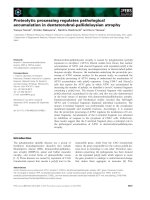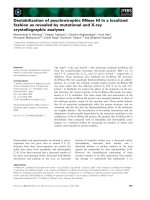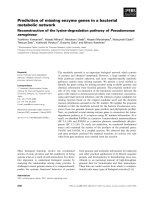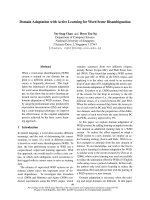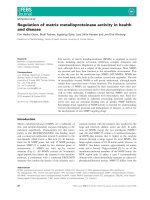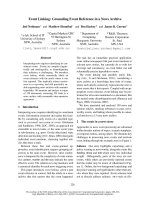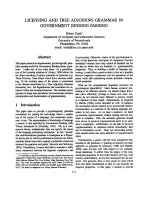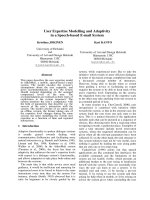Báo cáo khoa học: "Cholelithiasis associated with recurrent colic in a Thoroughbred mare" pdf
Bạn đang xem bản rút gọn của tài liệu. Xem và tải ngay bản đầy đủ của tài liệu tại đây (2.03 MB, 4 trang )
-2851$/ 2)
9H W H U L Q D U \
6FLHQFH
J. Vet. Sci.
(2004),
/
5
(1), 79–82
Cholelithiasis associated with recurrent colic in a Thoroughbred mare
Seung-ho Ryu, Ung-bok Bak, Chang-woo Lee
1,
* and Yonghoon Lyon Lee
2
Equine Hospital, Korea Racing Association, Kwachon 427-070, Korea
1
Department of Clinical Pathology, College of Veterinary Medicine, Seoul National University, Seoul 151-742, Korea
2
Department of Anesthesia, Pain Management and Perioperative Medicine, Boren Veterinary Medical Teaching Hospital and
College of Veterinary Medicine, Oklahoma State University, Stillwater, OK 74074, USA
A 13-year-old Thoroughbred mare, retired from race,
was admitted to Equine Hospital, Korea Racing
Association with signs of colic. One and a half months
following the previous treatment (second time) and 11 days
following her previous discharge (third time), the mare
repeatedly exhibited signs of colic and finally along with
icteric eyes. Routine medical treatment with intravenous
fluids, analgesics resulted in resolution of signs of colic in
the first and second admission. The condition of the mare
did not improve in the third admission despite over one
month supportive treatment and she was subject to
euthanasia at the request of the owner on the thirtyeighth
day of hospitalization (95 days from her first admission).
The clinical signs (fever, icterus, mild intermittent colic) in
conjunction with clinical laboratory findings (leukocytosis,
elevations of serum total bilirubin, direct bilirubin, alkaline
phosphatase, aspartate aminotransferase, gamma glutamyl
transferase, creatine phosphokinase, lactic dehydrogenase
and blood fibrinogen indicative of obstructive biliary
disease) in this mare suggested possible chlolelithiasis.
However, liver enzymes and bilirubin estimations are often
not part of routine screening in emergency colic cases. At
necropsy, multiple dark brown choleliths of various sizes
obstructing hepatopancreatic ampulla were found in the
hepatic duct. The choleliths were found as large as 3-5 cm
in diameter, faceted to each other, dark brown in color and
showed soap consistency. Histopathologic findings revealed:
biliary fibrosis, plugging of the bile canaliculi with bile
pigments, cholangiohepatitis and pigmentation of the
hepatic lymph node with bile pigment laden macrophages.
Although definitive diagnosis of cholelithiasis might be
challenging, clinicians should consider this condition in the
differential diagnosis of recurrent colic.
Key words:
cholelithiasis, colic, horse
Choleliths have been described in a variety of domestic
animals including cats [9,11], dogs [10,16], sheep [17],
cattle [2], pigs [1,18] and horses [6,20,21,23]. Although it is
accepted that choleliths are uncommon in horses, Scarratt,
Saunders and Fessler [15] reviewed 13 cases. Two reports in
the literature describe successful treatment [12,22] involving
the fragmentation of the gall stone within the bile duct. The
duct was not opened and the fragments were massaged
towards the duodenum. Traub
et al
. (19) described the
removal of a cholelith from the common bile duct, however
this horse was destroyed 3 days later.
This report describes obstructive biliary disease associated
recurrent colic resulting from the unusual cholelithiasis in a
Thoroughbred mare.
Case history and clinical findings:
A 13-year-old
Thoroughbred mare, retired from race, was admitted to
Equine Hospital, Korea Racing Association with signs of
colic. The mare was depressed and sweating mildly at the
initial physical examination. Heart and respiratory rates per
minute were at 46 and 22, respectively. Hyperthermia was
present (39
o
C). Pallor and yellow coloration of the
conjunctiva were noticed. Routine medical treatment with
intravenous fluids, analgesics resulted in resolution of signs
of colic at the initial admission.
One and a half months following the previous treatment,
the mare again exhibited signs of colic. Heart and
respiratory rates per minute were at 42 and 24, respectively.
Body temperature was 38
o
C. The mucous membrane was
congested. Rectal palpation revealed no specific findings.
The color of urine was dark brown. Again routine medical
treatment as above resulted in resolution of signs of colic.
Eleven days following her previous discharge along with
decreased appetite and icteric eyes, the mare was presented
again to Equine Hospital of KRA. She had abnormal serum
biochemical parameters including elevations of total
bilirubin (8.7 mg/dl), direct bilirubin (3.1 mg/dl), alkaline
phosphatase (957 IU/L), aspartate aminotransferase (576
IU/L), gamma glutamyl transferase (480 IU/L), creatine
phosphokinase (155 IU/L), lactic dehydrogenase (934.2 IU/
L) and fibrinogen (400 mg/dl).
*Corresponding author
Phone: 82-2-880-1273; Fax: 82-2-880-8662
E-mail:
Case Report
80 Seung-ho Ryu
et al.
She also had abnormalities in hematological parameters
including elevated PCV (55%) and WBC counts (11,055/
µ
l). Abdominal paracentesis yielded approximately 3 L of
bloody peritoneal fluid. The clinical and laboratory findings
prompted the suspected liver disease. The condition of the
mare did not improve despite over one month supportive
treatment and she was subject to euthanasia at the request of
the owner on the thirty eighth day of hospitalization (95
days from her first admission).
Pathological findings: A complete gross and histological
examination was performed. At necropsy, multiple dark
brown choleliths of various sizes obstructing
hepatopancreatic ampulla were found in the hepatic duct
(Fig. 1). The choleliths were found as large as 3-5 cm in
diameter, faceted to each other, dark brown in color and
showed soap consistency. Hepatic duct and hepatopancreatic
ampulla were much dilated (Fig. 2). The liver was swollen,
cirrhotic and yellow brownish in color (Fig. 3). There was a
network of thickened interlobular speta of the liver.
Histopathologic findings revealed: biliary fibrosis (Fig. 4),
plugging of the bile canaliculi with bile pigments (Fig. 5),
cholangiohepatitis (Fig. 6) and pigmentation of the hepatic
lymph node with bile pigment laden macrophages.
The scarcity of information regarding equine bile stones
and the anatomical differences of the horses biliary system
in horses render cholelithiasis an unlikely differential
diagnosis. But the clinical signs (fever, icterus, mild
intermittent colic) in conjunction with clinical laboratory
findings (leukocytosis, elevations of serum total bilirubin,
direct bilirubin, alkaline phosphatase, aspartate
aminotransferase, gamma glutamyl transferase, creatine
phosphokinase, lactic dehydrogenase and blood fibrinogen)
indicative of obstructive biliary disease in this mare
suggested possible chlolelithiasis. However, liver enzymes
and bilirubin estimations are often not part of routine
screening in emergency colic cases. This case underlines the
F
ig. 1.
The figure shows several choleliths faceted to each oth
er
i
n the dilated hepatopancreatic ampulla (h).
F
ig. 2.
The figure shows the obstructed hepatopancreatic ampu
lla
(
arrow) and dilated hepatic duct (h).
F
ig. 3.
The figure shows the swollen cirrhotic liver lobes.
F
ig. 4.
The hepatic lobules shows extensive fibrosis of the por
tal
t
riad (t) and the limitating plate (l). Hematoxylin and eosin sta
in
5
0×.
Cholelithiasis associated with recurrent colic in a Thoroughbred mare 81
need to consider the assessment of liver status in recurrent
colic cases.
Although it is accepted that choleliths are uncommon in
horses, cholelithiasis is the most common cause of biliary
obstruction in horses. Proposed mechanisms include
ascariasis [6], biliary stasis, biliary infection and changes in
bile composition [8]. A foreign body acted as the nidus for
bile-salt deposition and ascending cholangitis [4]. Estrogens
could promote gallstone formation by alteration of biliary
lipids and cholesterol nucleation time [22]. A large cholelith
was the cause of the duodenal obstruction [7]. No
aetiological agent was found or proposed in this case.
Radiographic imaging of the equine abdomen is not
feasible. The use of ultrasound as a diagnostic imaging
modality allowed positive identification of bile stones in
equine patients [12]. Ultrasonographic findings accurately
depicted the histologic changes in the hepatic parenchyma in
horses with cholelithiasis. Ultrasonographic findings
revealed greater than normal amount of hepatic
parenchyma. The echogenicity of the liver was greater than
normal, and thick distended bile ducts were seen [3,13].
Ultrasonographic assessment along with serum biochemical
analysis would improve diagnostic accuracy of cholelithiasis
in equine patients.
Intermittent colic in the horse, unless related to a septic
focus, is unlikely to be accompanied by pyrexia and so the
presence of fever should perhaps have been suggestive of
cholangitis [5]. Successful surgical treatments of
cholelithiasis in horses have been described [5,14,19,21].
Although definitive diagnosis of cholelithiasis might be
challenging, clinicians should consider this condition in the
differential diagnosis of recurrent colic.
References
1. Danalis J, Penny RHC. Cholelithiasis in a sow. Aust Vet J
1967, 43, 119.
2. Ford EJH. A case of biliary calculus and jaundice in a cow.
Vet Rec 1955, 67, 634-635.
3. Freestone JF. Use of ultrasonography to diagnose a cholelith
in a 5-year-old horse. Aust Vet J 1989, 66, 304-5.
4. Gerros TC, McGuirk SM, Biller DS, Stone WC, Ryan J.
Choledocholithiasis attributable to a foreign body in a horse.
J Am Vet Med Assoc 1993, 202, 301-3.
5. Green DS, Davies JV. Successful choledocholithotomy in a
horse. Equine Vet J 1989, 21, 464-7.
6. Kataria RS, Verma GP. Intrahepatic stones in the horse.
Indian Vet J 1967, 44, 1025-1029.
7. Laverty S, Pascoe JR, Williams JW, Funk KA. Cholelith
causing duodenal obstruction in a horse. J Am Vet Med
Assoc 1992, 201, 751-2.
8. McDole MG. Cholelithiasis in a horse. Equine Practice,
1980, 2, 37-40.
9. Naus MJA, Jones BR. Cholelithiasis and
choledocholithiasis in a cat. N Z Vet J 1978, 26, 160-161.
10. Nelson NC, Piker JP, Welsh RR. Cholelithiasis in a dog. J
Am Vet Med Assoc 1968, 152, 47-50.
11. OBrien TR, Mitchum GD. Cholelithiasis in a cat. J Am Vet
Med Assoc 1970, 156, 1015-1017.
12. Rantanen NW Diseases of the liver. Vet Clin North Am
Equine Pract 1986, 2, 105-14.
13. Reef VB, Johnston JK, Divers TJ, Acland H.
Ultrasonographic findings in horses with cholelithiasis: eight
cases (1985-1987). J Am Vet Med Assoc 1990, 196, 1836-40.
14. Roussel AJ Jr, Becht JL, Adams SB. Choledocholithiasis in
a horse. Cornell Vet 1984, 74, 166-71.
15. Scarratt WK, Saunders GK, Fessler RL. Cholelithiasis
and biliary obstruction in a horse. Compend Contin Educ
Pract Vet 1985, 7, S428-S431.
16. Scott DW, Hoffer RE, Amand WB. Cholelithiasis in a dog.
J Am Vet Med Assoc 1973, 163, 254-257.
17. Shumand RF, Eveleth DF. Cholelithiasis in a ewe. Vet Med
1955, 50, 217.
18. Splitter GA. Cholelithiasis in a pig. Vet Rec 1972, 90, 73.
F
ig. 5. The figure shows bile stasis in the bile canaliculi (arrow
)
H
ematoxylin and eosin stain 200×.
F
ig. 6. The figure shows necrotic liver cells (p) and infiltration
of
g
ranulocytic leukocytes (arrows). Hematoxylin and eosin sta
in
4
00×.
82 Seung-ho Ryu
et al.
19.
Traub JL, Grant BD, Rantanen NW, McElwain T,
Wagner PC, Bayly WM.
Surgical removal of choleliths in a
horse. J Am Vet Med Assoc 1983,
182
, 714-6.
20.
Traub JL, Rantanen N, Reed S, Schecter L.
Cholelithiasis
in four horses. J Am Vet Med Assoc 1982,
181
, 59-62.
21.
Tulleners EP, Becht JL, Richardson DW, Divers TJ.
Choledocholithotripsy in a mare. J Am Vet Med Assoc 1985,
186
, 1317-9.
22.
Uhler ML, Marks JW, Voigt BJ, Judd HL.
Comparison of
the impact of transdermal versus oral estrogens on biliary
markers of gallstone formation in postmenopausal women. J
Clin Endocrinol Metab 1998,
83
, 410-4.
23.
Van der Luer RJ, Kroneman J.
Three cases of
cholelithiasis and biliary fibrosis in the horse. Equine Vet J
1982,
14
, 251-3.
